A Machine-Learning-Based Robust Classification Method for PV Panel Faults
Abstract
:1. Introduction
- We present a Convolutional-Neural-Network (CNN)-based automatic fault detection and classification method. The proposed machine learning model efficiently reduces power losses in solar PV systems by classifying faults due to its higher accuracy compared to those previously applied.
- We developed an intelligent and robust fault detection and classification technique, which is primarily based on machine learning methods. By using this novel approach, we obtained an increase in fault detection accuracy up to 97.5% from 92.64% compared to the Artificial-Neural-Network (ANN)-based model.
- To the best of our knowledge, the proposed CNN-based model has never been applied to such a big and unbalanced dataset before, for solar system fault detection application. We are optimistic that the proposed method will be a guideline for beginners and researchers who intend to initiate research in the PV domain using machine-learning-based methods.
2. Related Work
- The SC faults: SC faults are caused by an accidental connection between two PV array points with potential variable values. It can occur within the same string or between two adjacent ones [17].
- Partial shading: Partial shading is the situation where the PV modules are partially shaded, not receiving proper sunlight to produce energy. It is a temporary situation that causes a decrease in output power [15]. There are two categories of shading [18]. The first is static shading, whereas the second is dynamic shading. Static shading is created by the accumulation of dust, leaves, and bird droppings on the glass, whereas dynamic shading is caused by a momentary shadow cast by surrounding buildings or trees.
- Degradation: PV systems are susceptible to degradation owing to front surface soiling, optical degradation due to continuous exposition to UV light, a rise in series resistance or a decrease in shunt resistance, a reduction in the SC current, etc. [19,20]. This error may be module-specific or occur over the entire array over time, resulting in a decline in system performance.
3. Proposed Method
| Algorithm 1: CNN algorithm for PV fault detection. |
|
4. Simulation Results
4.1. Dataset Description
- voltage of string 1;
- voltage of string 2;
- current of string 1;
- current of string 2;
- irradiation level;
- temperature of PV panel;
- fault label.
4.2. Dataset Preprocessing
4.3. The CNN Performance Analysis
4.4. Accuracy Curves
4.5. Confusion Matrix
4.6. Comparison
- It can be seen in Table 1 that, among all the compared methods, the work reported in [13] yielded the least accuracy of 73.53% to classify the multi-class faults, such as the LL, the OC, and partial shading faults. This was due to the fact that, in their method, the last few layers of a pre-trained AlexNet are fine-tuned to produce several types of outputs. Similarly, the authors also obtained features from the fully connected (fc7) layer of a pre-trained AlexNet and then used this in conjunction with classical ML methods for classification.
- The works reported in [26,32] yielded the same 97% fault detection accuracy. In particular, the developed method in [26] uses the SVM framework to classify only the LL and the OC faults, whereas Reference [32] successfully classified the GF, the OC, the SC, and hotspot faults by utilizing the PNN framework to yield a similar accuracy.
- Moreover, the authors of [29] also achieved a 92.64% fault detection accuracy for the multi-class faults, such as the OC, the SC, degradation, and shadowing. This is an interesting solution in the fault detection domain, where the authors introduced a recursive linear model to detect faults in the system, primarily through the use of irradiance on the PV panel as the input signals and power as the output.
- Similarly, the work published in [33], utilized a probabilistic framework to classify various faults and, thereby, yielded a good accuracy of 94.69%. This model is also a novel contribution to the fault detection domain and achieved encouraging results by employing several sequential steps. Initially, the authors analyzed the performance of seven indicators to accurately predict the nonlinear output behavior of the PV system under changing environmental conditions. Moreover, several fault cases, considering single-fault types and another three faults considering multiple fault types, were also investigated. In the final stages of this sequential algorithm, the typical fault types were classified and detected using sequential probabilistic neural network models, which gave an effective classification of the data inputs.
- The aforedescribed works are sound solutions in the PV domain to reliably detect and classify various faults. However, as seen in Table 1, the proposed fault detection model yielded the highest accuracy among all the compared works. Moreover, our developed CNN-based fault detection model yielded much better accuracy than [13], who also used the CNN framework. On the multi-class dataset developed by [29], we were able to improve the multi-class fault detection accuracy by 5% and 24.11% compared to [13]. Our study indicates that the higher fault detection accuracy in our work was made possible due to the intelligent utilization of the Application Program Interfaces (APIs), which encouraged us to design and operate different layers of the CNN model. Moreover, Google Tensorflow perfectly created and managed these APIs. Furthermore, our proposed method allows real-time fault detection and classification. The training samples along with the actual labels were fed to the training phase of the CNN, which involved various layers, such as convolutional, pooling, flatten, and dense layers, resulting in the intelligently trained CNN model. Later, this model handled the test samples effectively.
4.7. Computational Complexity
5. Discussion
- Our study indicated that there is a severe lack of standard protocols to generate and analyze various faults. Similarly, there is a scarcity of available diverse public datasets. We are optimistic that future studies will present more diverse datasets to detect, identify, and classify various faults.
- Our proposed fault detection model classified five different types of fault cases efficiently. However, we observed that the proposed CNN-based fault detection model is heavy compared to other machine algorithms, such as the Discrete Fourier Transform (DFT) and the SVM. Moreover, our proposed model presented a comparable performance to the other works listed in Table 1.
- Our proposed model works in a near real-time fault detection and classification manner. Similarly, our findings suggest that shadowing events are caused by real shadowing, which makes them a challenging task to be accurately characterized. Similarly, controlled shadowing normally increases the performance for a class.
6. Conclusions
Author Contributions
Funding
Institutional Review Board Statement
Informed Consent Statement
Data Availability Statement
Conflicts of Interest
Abbreviations
| AFCI | Arc Fault Circuit Interrupter |
| ANN | Artificial Neural Network |
| API | Application Programming Interface |
| CNN | Convolutional Neural Network |
| DCNN | Deep Convolutional Neural Network |
| DT | Decision Tree |
| FC Layer | Fully Connected Layer |
| GF | Ground Fault |
| GFPD | Ground Fault Protection Device |
| GW | Gigawatt |
| IREA | International Renewable Energy Agency |
| KW | Kilowatt |
| LL | Line-to-Line |
| NEC | National Electric Code |
| NLP | Natural Language Processing |
| OC | Open-Circuit |
| OCPD | Over-Current Protection Device |
| PV | Photovoltaic |
| PNN | Probabilistic Neural Network |
| RGB | Red Green Blue |
| SC | Short-Circuit |
| SVM | Support Vector Machine |
| UV | Ultraviolet |
References
- Antonanzas, J.; Quinn, J. Net environmental impact of the PV industry from 2000–2025. J. Clean. Prod. 2021, 311, 127791. [Google Scholar] [CrossRef]
- Adhya, D.; Chatterjee, S.; Chakraborty, A.K. Performance assessment of selective machine learning techniques for improved PV array fault diagnosis. Sustain. Energy Grids Netw. 2022, 29, 100582. [Google Scholar] [CrossRef]
- Bosman, L.B.; Leon-Salas, W.D.; Hutzel, W.; Soto, E.A. PV system predictive maintenance: Challenges, current approaches, and opportunities. Energies 2020, 13, 1398. [Google Scholar] [CrossRef] [Green Version]
- Shahzad, M.; Shafiullah, Q.; Akram, W.; Arif, M.; Ullah, B. Reactive power support in radial distribution network using mine blast algorithm. Elektron. Elektrotech. 2021, 27, 33–40. [Google Scholar] [CrossRef]
- Shahzad, M.; Gawlik, W.; Palensky, P. Voltage Quality Index based method to quantify the advantages of optimal DG placement. In Proceedings of the 2016 Eighteenth International Middle East Power Systems Conference (MEPCON), Cairo, Egypt, 27–29 December 2016; pp. 759–764. [Google Scholar]
- Shahzad, M.; Akram, W.; Arif, M.; Khan, U.; Ullah, B. Optimal siting and sizing of distributed generators by strawberry plant propagation algorithm. Energies 2021, 14, 1744. [Google Scholar] [CrossRef]
- Shahzad, M.; Ahmad, I.; Gawlik, W.; Palensky, P. Active power loss minimization in radial distribution networks with analytical method of simultaneous optimal DG sizing. In Proceedings of the 2016 IEEE International Conference on Industrial Technology (ICIT), Taipei, Taiwan, 14–17 March 2016; pp. 470–475. [Google Scholar]
- Ji, D.; Zhang, C.; Lv, M.; Ma, Y.; Guan, N. Photovoltaic array fault detection by automatic reconfiguration. Energies 2017, 10, 699. [Google Scholar] [CrossRef] [Green Version]
- Pillai, D.S.; Rajasekar, N. A comprehensive review on protection challenges and fault diagnosis in PV systems. Renew. Sustain. Energy Rev. 2018, 91, 18–40. [Google Scholar] [CrossRef]
- Chen, Z.; Wu, L.; Cheng, S.; Lin, P.; Wu, Y.; Lin, W. Intelligent fault diagnosis of photovoltaic arrays based on optimized kernel extreme learning machine and IV characteristics. Appl. Energy 2017, 204, 912–931. [Google Scholar] [CrossRef]
- Kim, J.; Rabelo, M.; Padi, S.P.; Yousuf, H.; Cho, E.C.; Yi, J. A review of the degradation of photovoltaic modules for life expectancy. Energies 2021, 14, 4278. [Google Scholar] [CrossRef]
- Appiah, A.Y.; Zhang, X.; Ayawli, B.B.K.; Kyeremeh, F. Review and performance evaluation of photovoltaic array fault detection and diagnosis techniques. Int. J. Photoenergy 2019, 2019. [Google Scholar] [CrossRef]
- Aziz, F.; Haq, A.U.; Ahmad, S.; Mahmoud, Y.; Jalal, M.; Ali, U. A novel convolutional neural network-based approach for fault classification in photovoltaic arrays. IEEE Access 2020, 8, 41889–41904. [Google Scholar] [CrossRef]
- Pillai, D.S.; Rajasekar, N. An MPPT-based sensorless line–line and line–ground fault detection technique for PV systems. IEEE Trans. Power Electron. 2018, 34, 8646–8659. [Google Scholar] [CrossRef]
- Kumar, B.P.; Ilango, G.S.; Reddy, M.J.B.; Chilakapati, N. Online fault detection and diagnosis in photovoltaic systems using wavelet packets. IEEE J. Photovoltaics 2017, 8, 257–265. [Google Scholar] [CrossRef]
- Kase, R.; Nishikawa, S. Fault detection of bypass circuit of PV module—Detection technology of open circuit fault location. In Proceedings of the 2016 19th International Conference on Electrical Machines and Systems (ICEMS), Chiba, Japan, 13–16 November 2016; pp. 1–4. [Google Scholar]
- Pillai, D.S.; Blaabjerg, F.; Rajasekar, N. A comparative evaluation of advanced fault detection approaches for PV systems. IEEE J. Photovoltaics 2019, 9, 513–527. [Google Scholar] [CrossRef]
- Shenoy, K.L.; Nayak, C.G.; Mandi, R.P. Effect of partial shading in grid connected solar pv system with fl controller. Int. J. Power Electron. Drive Syst. 2021, 12, 431. [Google Scholar] [CrossRef]
- Piliougine, M.; Guejia-Burbano, R.; Petrone, G.; Sánchez-Pacheco, F.; Mora-López, L.; Sidrach-de Cardona, M. Parameters extraction of single diode model for degraded photovoltaic modules. Renew. Energy 2021, 164, 674–686. [Google Scholar] [CrossRef]
- Noman, M.; Tu, S.; Ahmad, S.; Zafar, F.U.; Khan, H.A.; Rehman, S.U.; Waqas, M.; Khan, A.D.; Rehman, O.U. Assessing the reliability and degradation of 10–35 years field-aged PV modules. PLoS ONE 2022, 17, e0261066. [Google Scholar] [CrossRef]
- Qian, X.; Li, J.; Cao, J.; Wu, Y.; Wang, W. Micro-cracks detection of solar cells surface via combining short-term and long-term deep features. Neural Netw. 2020, 127, 132–140. [Google Scholar] [CrossRef]
- Zhang, X.; Hao, Y.; Shangguan, H.; Zhang, P.; Wang, A. Detection of surface defects on solar cells by fusing Multi-channel convolution neural networks. Infrared Phys. Technol. 2020, 108, 103334. [Google Scholar] [CrossRef]
- Alves, R.H.F.; de Deus Júnior, G.A.; Marra, E.G.; Lemos, R.P. Automatic fault classification in photovoltaic modules using Convolutional Neural Networks. Renew. Energy 2021, 179, 502–516. [Google Scholar] [CrossRef]
- Espinosa, A.R.; Bressan, M.; Giraldo, L.F. Failure signature classification in solar photovoltaic plants using RGB images and convolutional neural networks. Renew. Energy 2020, 162, 249–256. [Google Scholar] [CrossRef]
- Ali, M.U.; Khan, H.F.; Masud, M.; Kallu, K.D.; Zafar, A. A machine learning framework to identify the hotspot in photovoltaic module using infrared thermography. Sol. Energy 2020, 208, 643–651. [Google Scholar] [CrossRef]
- Wang, J.; Gao, D.; Zhu, S.; Wang, S.; Liu, H. Fault diagnosis method of photovoltaic array based on support vector machine. Energy Sources Part A Recover. Util. Environ. Eff. 2019, 1–16. [Google Scholar] [CrossRef]
- Eskandari, A.; Milimonfared, J.; Aghaei, M.; Reinders, A.H. Autonomous monitoring of Line-to-Line faults in photovoltaic systems by feature selection and parameter optimization of support vector machine using genetic algorithms. Appl. Sci. 2020, 10, 5527. [Google Scholar] [CrossRef]
- Eskandari, A.; Milimonfared, J.; Aghaei, M. Optimization of SVM classifier using Grid Search Method for Line-Line Fault Detection of Photovoltaic Systems. In Proceedings of the 2020 47th IEEE Photovoltaic Specialists Conference (PVSC), Calgary, AB, Canada, 15 June–21 August 2020; pp. 1134–1137. [Google Scholar]
- Lazzaretti, A.E.; Costa, C.H.d.; Rodrigues, M.P.; Yamada, G.D.; Lexinoski, G.; Moritz, G.L.; Oroski, E.; Goes, R.E.d.; Linhares, R.R.; Stadzisz, P.C.; et al. A monitoring system for online fault detection and classification in photovoltaic plants. Sensors 2020, 20, 4688. [Google Scholar] [CrossRef]
- Hussain, M.; Dhimish, M.; Titarenko, S.; Mather, P. Artificial neural network based photovoltaic fault detection algorithm integrating two bi-directional input parameters. Renew. Energy 2020, 155, 1272–1292. [Google Scholar] [CrossRef]
- Basnet, B.; Chun, H.; Bang, J. An intelligent fault detection model for fault detection in photovoltaic systems. J. Sens. 2020, 2020, 6960328. [Google Scholar] [CrossRef]
- Wang, X.X.; Dong, L.; Liu, S.Y.; Hao, Y.; Wang, B. A Fault Classification Method of Photovoltaic Array Based on Probabilistic Neural Network. In Proceedings of the 2019 Chinese Control And Decision Conference (CCDC), Nanchang, China, 3–5 June 2019; pp. 5260–5265. [Google Scholar]
- Zhu, H.; Ahmed, S.A.Z.; Alfakih, M.A.; Abdelbaky, M.A.; Sayed, A.R.; Saif, M.A.A. Photovoltaic failure diagnosis using sequential probabilistic neural network model. IEEE Access 2020, 8, 220507–220522. [Google Scholar] [CrossRef]
- Zhu, H.; Lu, L.; Yao, J.; Dai, S.; Hu, Y. Fault diagnosis approach for photovoltaic arrays based on unsupervised sample clustering and probabilistic neural network model. Sol. Energy 2018, 176, 395–405. [Google Scholar] [CrossRef]
- Sun, E. Small-scale image recognition based on Cascaded Convolutional Neural Network. In Proceedings of the 2021 IEEE 5th Advanced Information Technology, Electronic and Automation Control Conference (IAEAC), Chongqing, China, 12–14 March 2021; Volume 5, pp. 2737–2741. [Google Scholar]
- Moon, W.K.; Lee, Y.W.; Ke, H.H.; Lee, S.H.; Huang, C.S.; Chang, R.F. Computer-aided diagnosis of breast ultrasound images using ensemble learning from convolutional neural networks. Comput. Methods Programs Biomed. 2020, 190, 105361. [Google Scholar] [CrossRef]
- Gao, Z.; Edirisinghe, E.; Chesnokov, S. Image super-resolution using CNN optimized by self-feature loss. In Proceedings of the 2019 IEEE International Conference on Image Processing (ICIP), Taipei, Taiwan, 22–25 September 2019; pp. 2816–2820. [Google Scholar]
- Ghorbani, R.; Ghousi, R. Comparing different resampling methods in predicting students’ performance using machine learning techniques. IEEE Access 2020, 8, 67899–67911. [Google Scholar] [CrossRef]
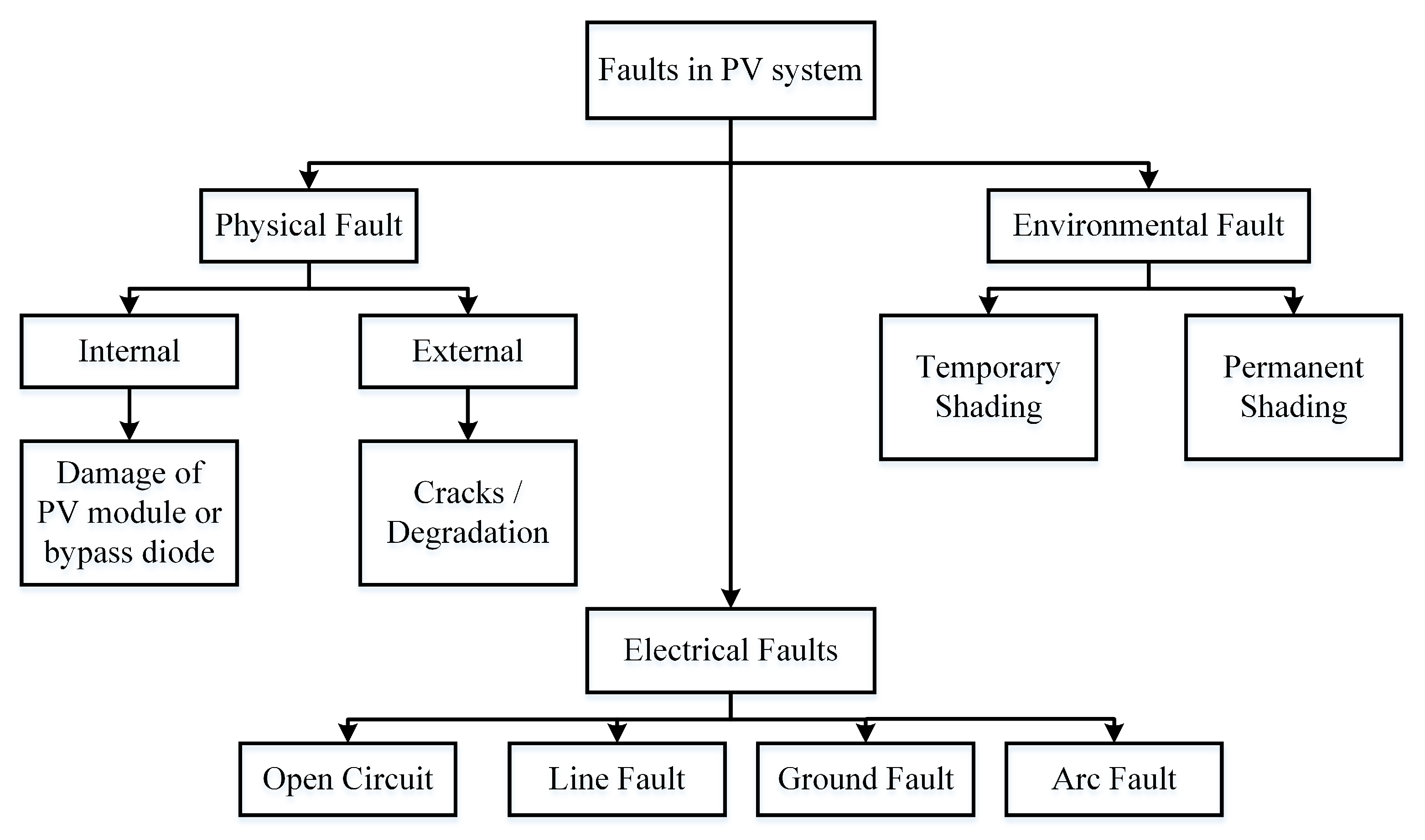
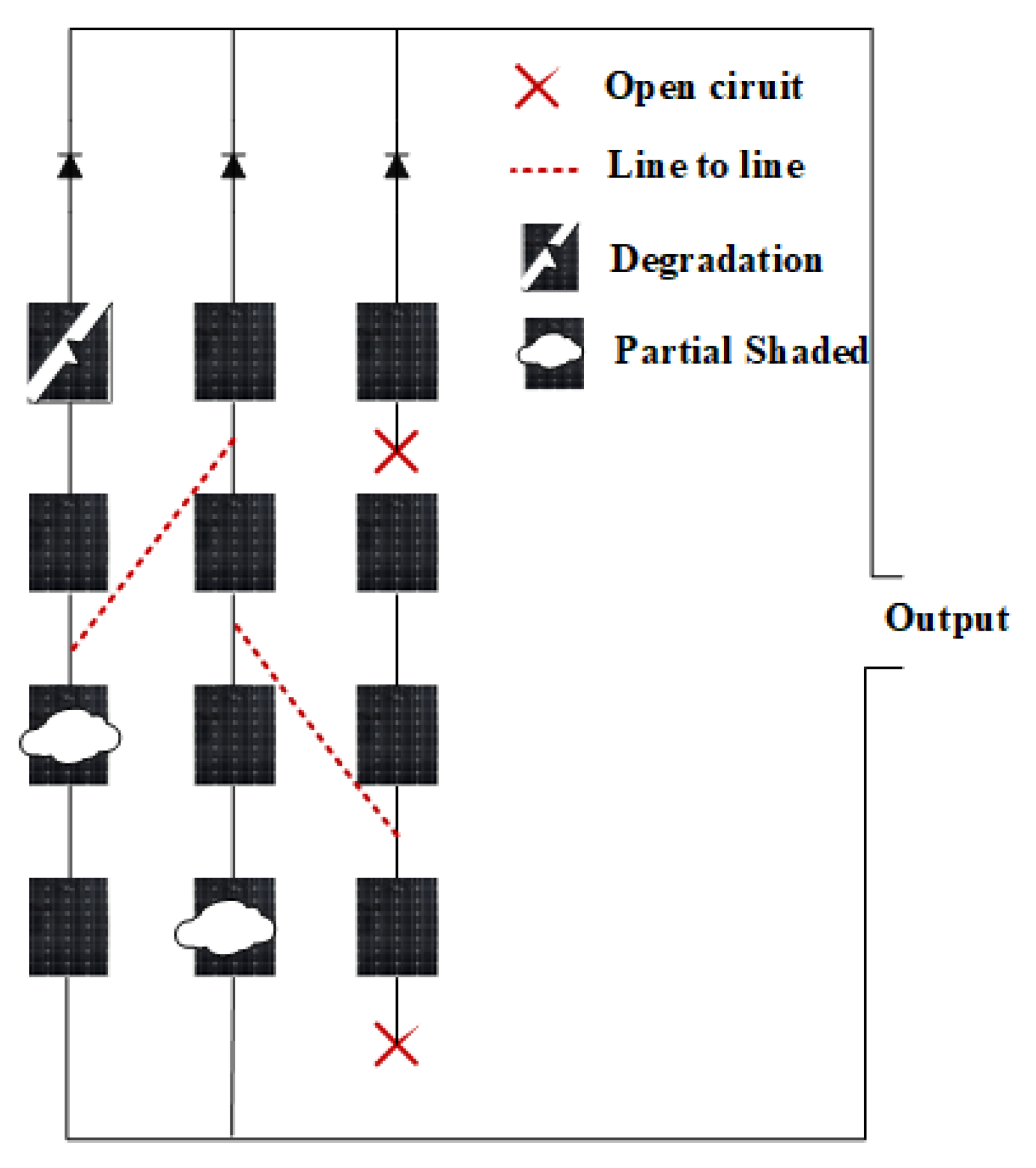
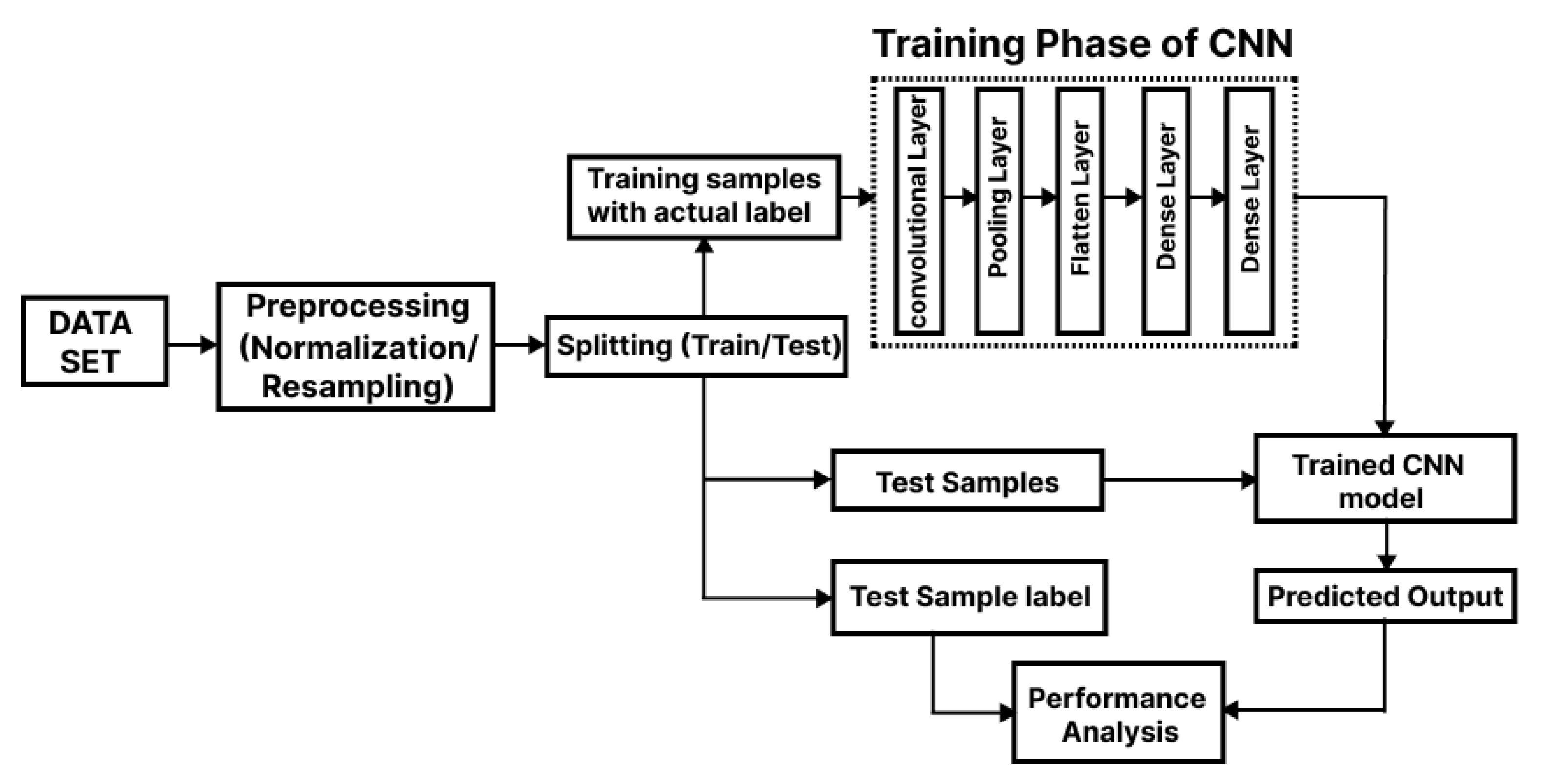
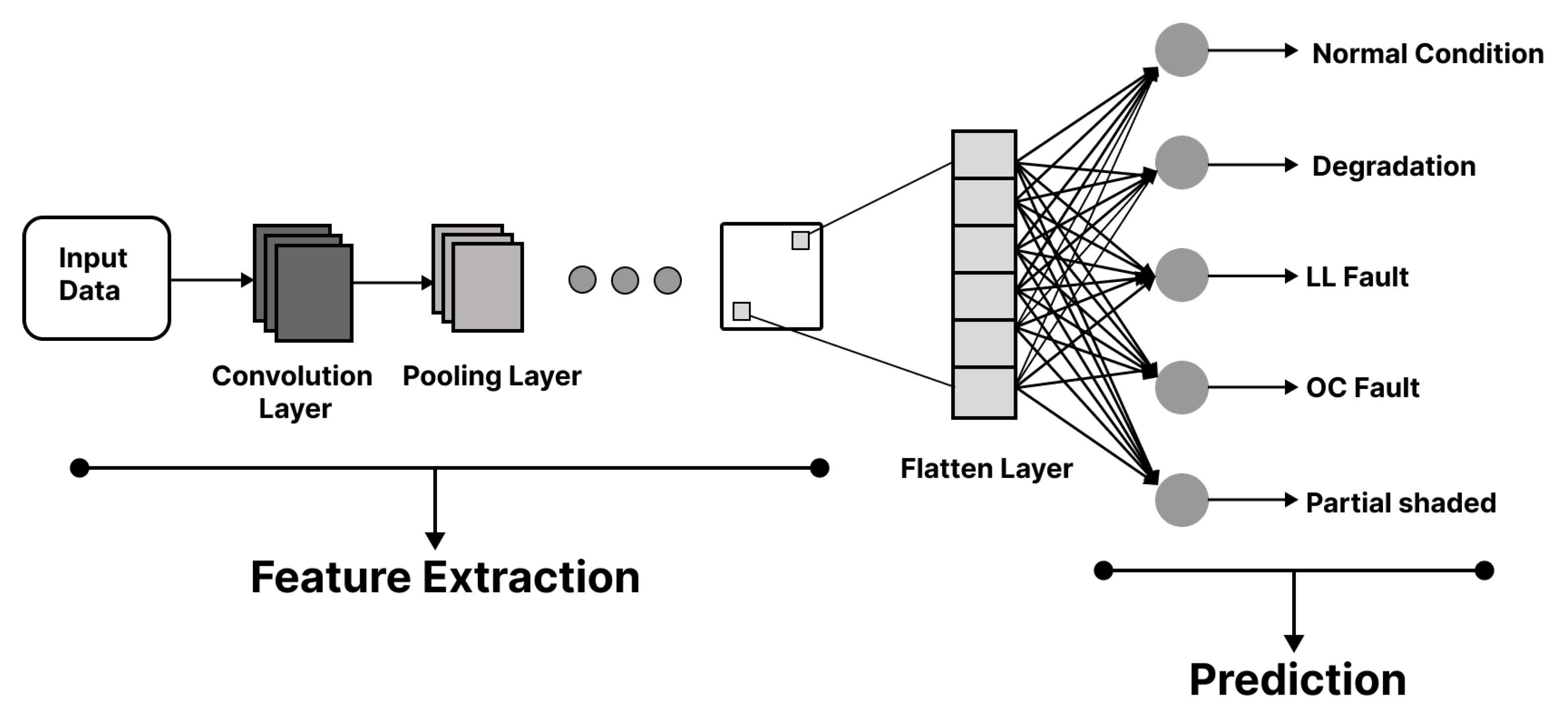


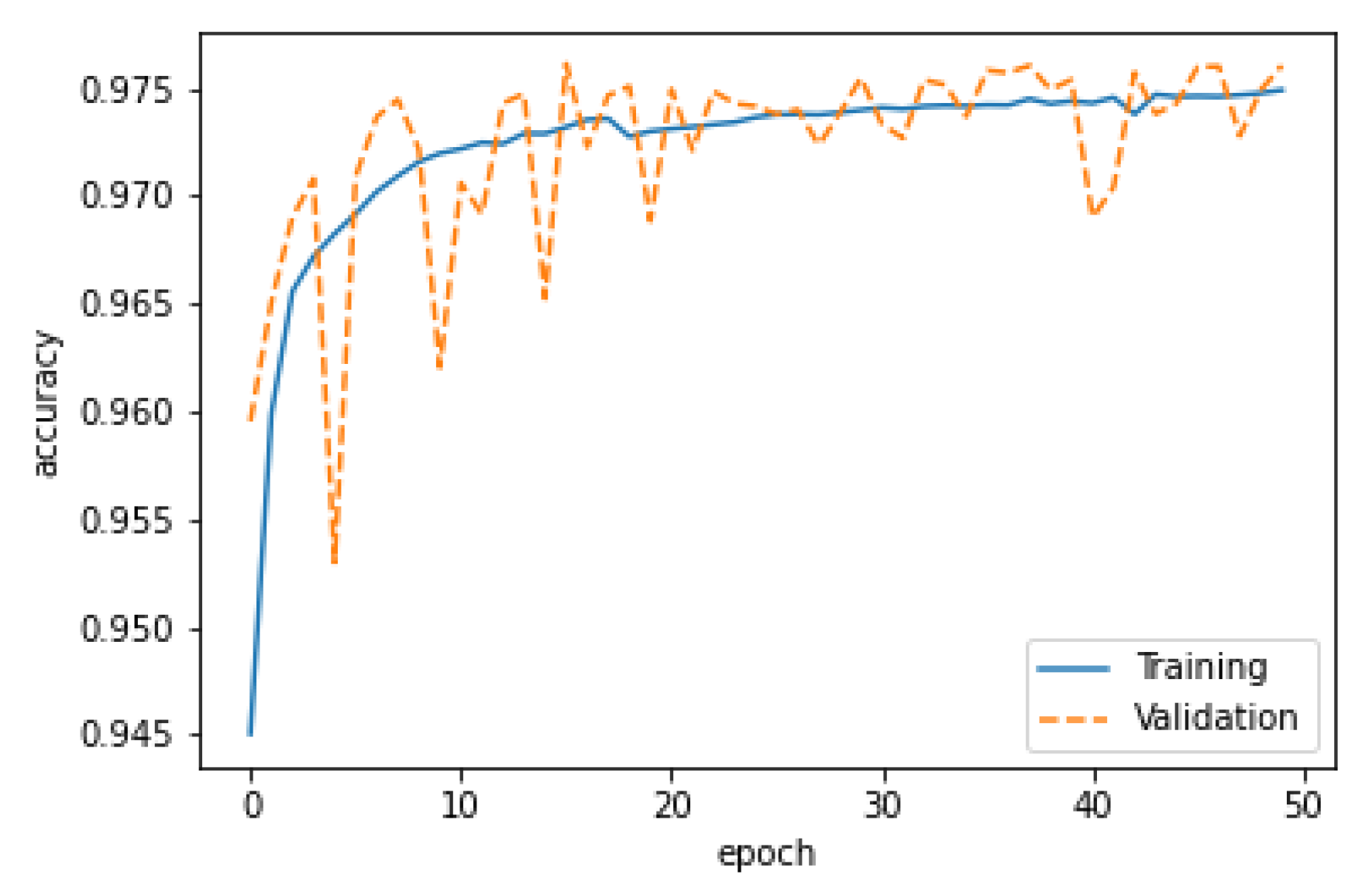
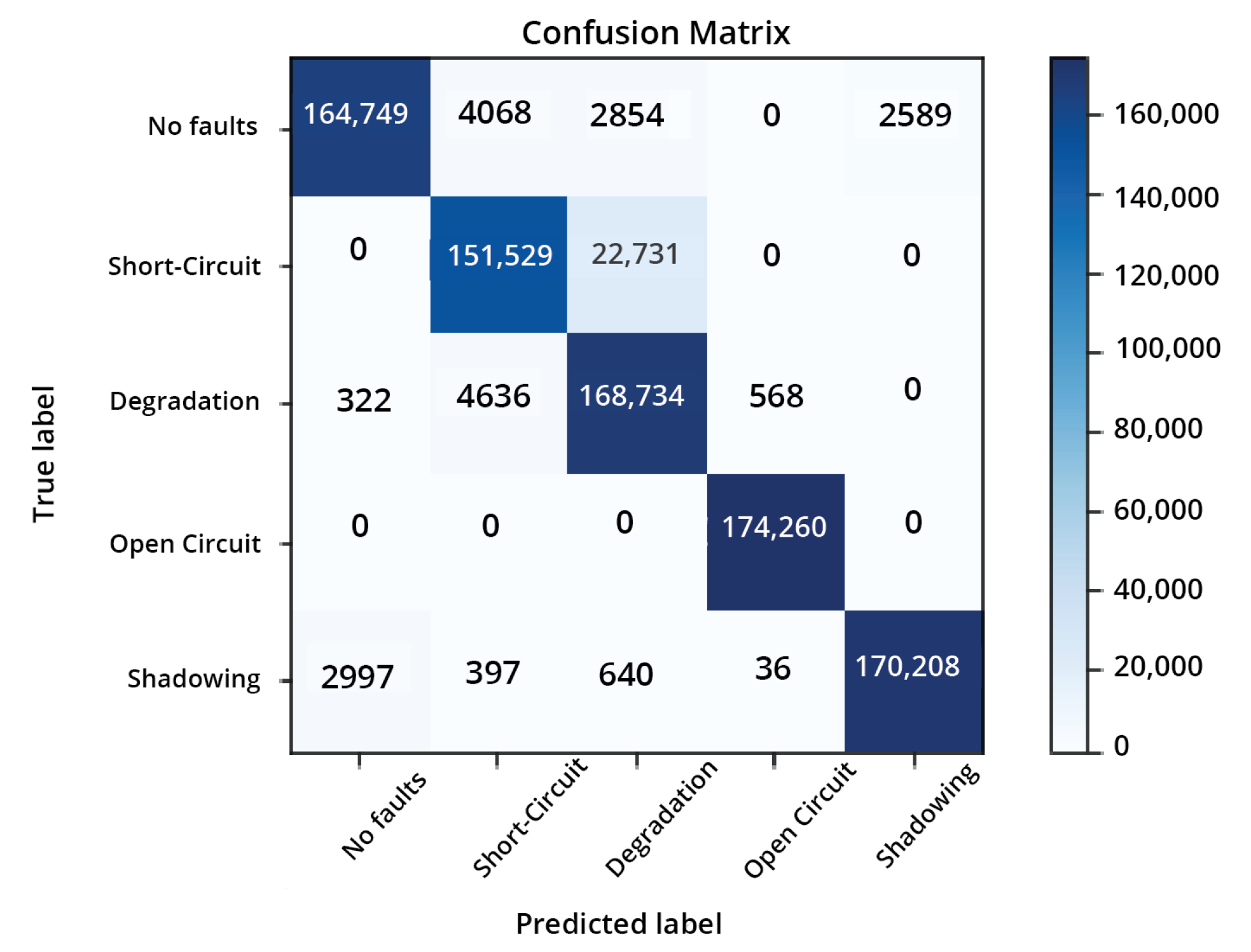
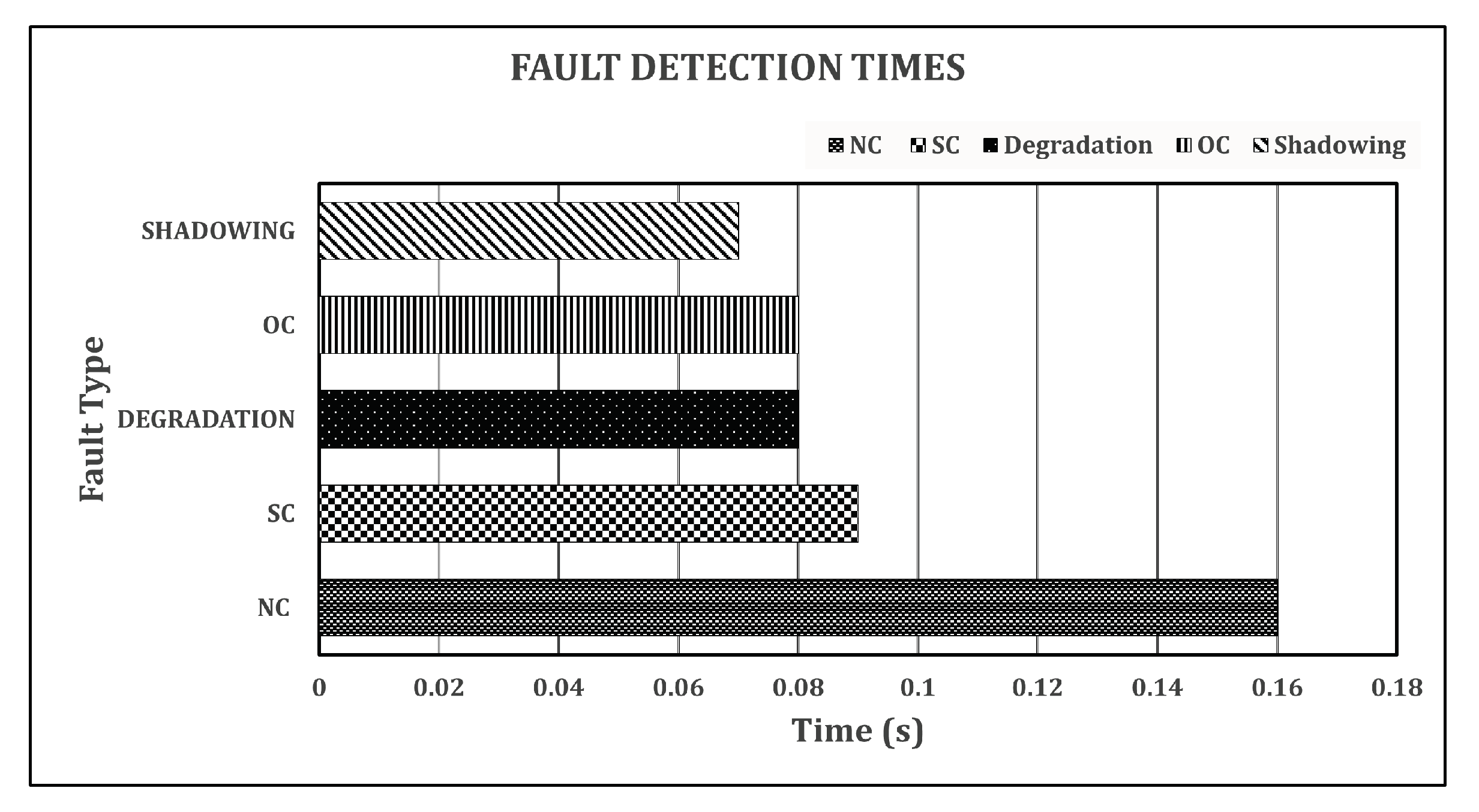
Publisher’s Note: MDPI stays neutral with regard to jurisdictional claims in published maps and institutional affiliations. |
© 2022 by the authors. Licensee MDPI, Basel, Switzerland. This article is an open access article distributed under the terms and conditions of the Creative Commons Attribution (CC BY) license (https://creativecommons.org/licenses/by/4.0/).
Share and Cite
Memon, S.A.; Javed, Q.; Kim, W.-G.; Mahmood, Z.; Khan, U.; Shahzad, M. A Machine-Learning-Based Robust Classification Method for PV Panel Faults. Sensors 2022, 22, 8515. https://doi.org/10.3390/s22218515
Memon SA, Javed Q, Kim W-G, Mahmood Z, Khan U, Shahzad M. A Machine-Learning-Based Robust Classification Method for PV Panel Faults. Sensors. 2022; 22(21):8515. https://doi.org/10.3390/s22218515
Chicago/Turabian StyleMemon, Sufyan Ali, Qaiser Javed, Wan-Gu Kim, Zahid Mahmood, Uzair Khan, and Mohsin Shahzad. 2022. "A Machine-Learning-Based Robust Classification Method for PV Panel Faults" Sensors 22, no. 21: 8515. https://doi.org/10.3390/s22218515
APA StyleMemon, S. A., Javed, Q., Kim, W.-G., Mahmood, Z., Khan, U., & Shahzad, M. (2022). A Machine-Learning-Based Robust Classification Method for PV Panel Faults. Sensors, 22(21), 8515. https://doi.org/10.3390/s22218515







